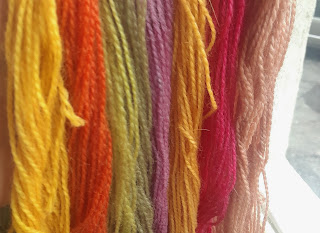Harvesting Color
 |
| Dyed yarn created by the author, using coreopsis, poplar, tansy, cochineal, and buckthorn as sources. |
Did you know that some of the most beautiful shades of red can be produced with the dried bodies of insects, or that lichens can create dye colors ranging from pretty pinks to mossy greens? The world of natural dye is a fascinating one, and the Museum's first director understood this well.
Humans learned in ancient times how to capture vibrant colors for their textiles using plants and invertebrates. Our species has continued to experiment with other biological sources as well as minerals into modern times. Use of natural dyes likely predates records, but there is written evidence of fabrics being dyed in areas of China around 2600 BC. Many plant sources readily produce shades of brown from tannins, or yellows and greens. Ancient Egyptians learned to use species of madder to produce reds, and some centuries later, purple was made from the veins of mollusks. Considerable efforts were taken to extract the most prized pigments for textiles and often only the royal or wealthy were able to afford fabrics of purple, blue, or red hues.
What halted such a fascination with natural dye materials? Mauve was accidentally discovered as the first synthetic dye stuff in 1856, and the textile industry quickly adjusted to rely on those synthetic materials rather than natural. Although times have changed, many continue to find inspiration in the colors of nature. Natural dyeing is still learned and shared widely, and many find wonder in locating natural materials and utilizing them to produce beautiful pieces of art.
 |
| The September 2018 Specimen of the Month includes three wool yarn samples dyed with one species of lichen. |
Like a true naturalist, Lois expertly observed the natural world. She understood each component through multiple lenses--a plant was not only a living organism, but also a food source for humans and other animals, a worthy subject for artwork, or a means to preserve the lovely hues of any season. In Wayside Bounty, Lois writes accounts on various plants as foods, but also makes a point to indicate a few of their dye properties. Of Rumex stenophyllus, or narrowleaf dock, Lois stated that its roots produce the finest yellow she had yet found. Clusters of green brier berries were noted as one of the few fruits to produce a blue dye--a color found in only a handful of natural sources.
A wealth of literature may be found on natural dyes, and I encourage anyone with a creative spirit to spend just a few minutes reading about these practices. I believe that Lois's life was certainly enhanced by her exploration of plant-born color. While I could likely write many pages about how an interest in natural dyes has brightened the lives of many among her, I believe that the colors of her craft speak for themselves.
 |
| An example of various pigments created by Lois Nestel. |